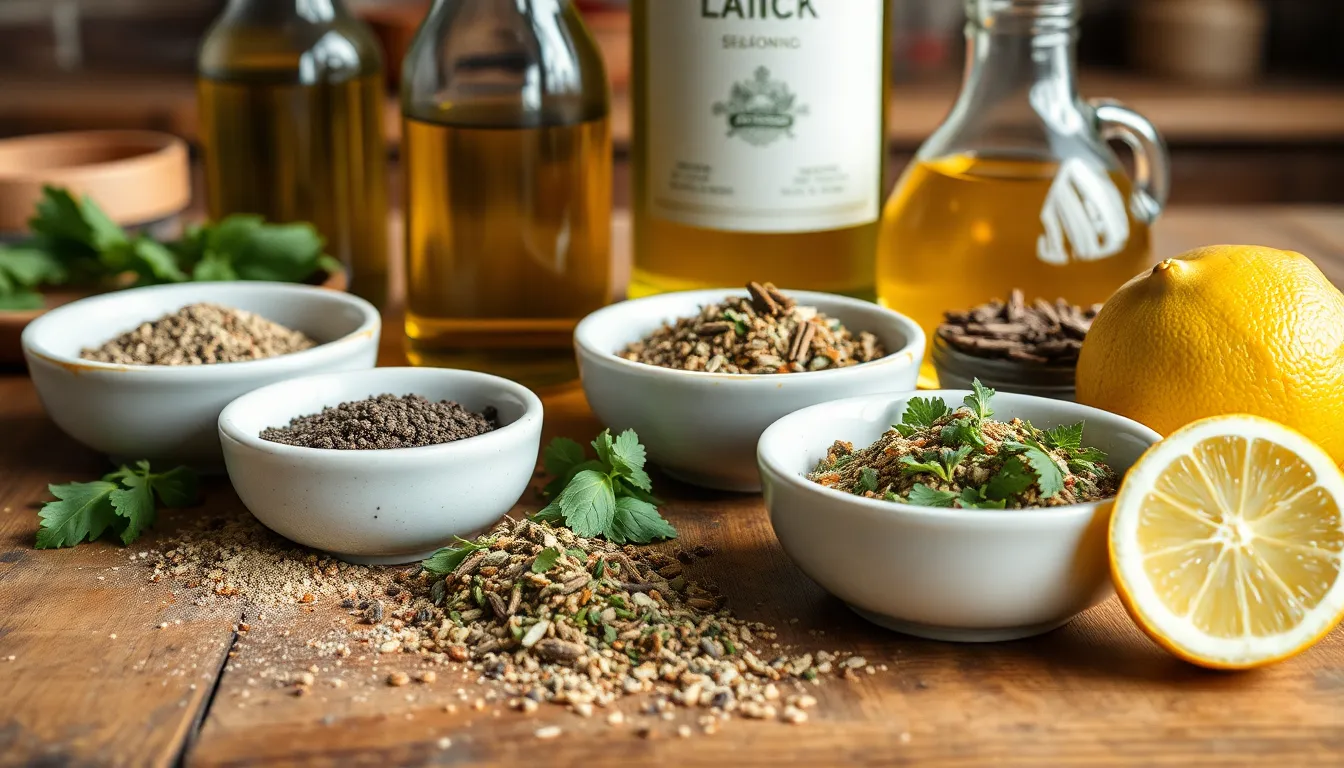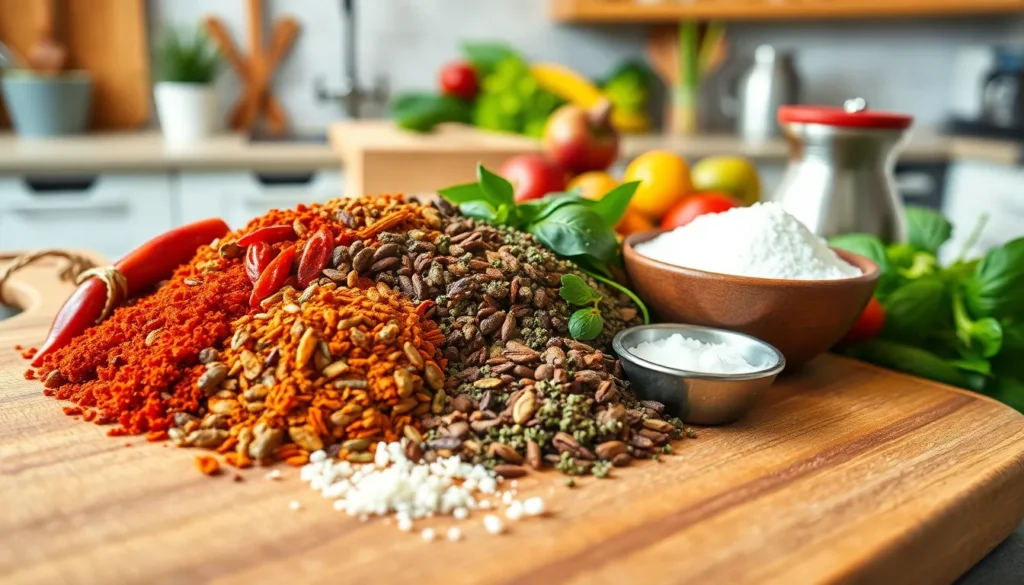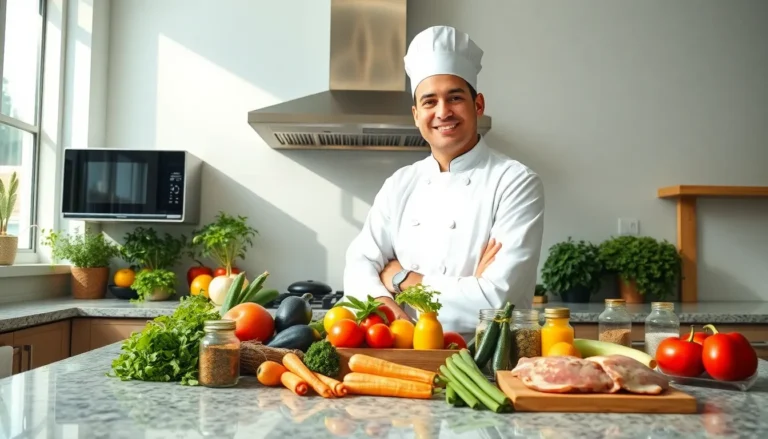Table of Contents
ToggleEvery great dish starts with a secret ingredient, and sometimes that ingredient’s just a sprinkle away. Seasoning methods can transform bland into grand, turning a simple meal into a culinary masterpiece. Whether it’s a dash of salt that makes taste buds dance or a blend of spices that takes dinner to exotic realms, mastering these techniques is essential for any aspiring chef.
But let’s face it, seasoning can be as tricky as finding a matching sock in the laundry. Too little and your dish falls flat; too much, and it’s a one-way ticket to flavor town chaos. Fear not! This guide dives into the art of seasoning like a pro, making sure every bite is packed with flavor and laughter. Get ready to elevate your cooking game and impress your friends, or at least make them giggle while you try.
Overview of Seasoning Methods
Seasoning encompasses a variety of techniques, each contributing distinct flavors and enhancing culinary experiences. Salt ranks as the most fundamental seasoning; it boosts natural flavors and balances sweetness. Herbs introduce aromatic notes; they come fresh or dried, with options like basil, thyme, and rosemary. Spices add warmth and complexity to dishes, with choices such as cumin, paprika, and cinnamon.
Brining offers an effective method for improving moisture and flavor in meats. The brine, typically a mixture of salt and water, permeates the food, creating a juicy result. Marinades, often consisting of acidic ingredients like vinegar or citrus juice, tenderize and flavor proteins before cooking. It’s crucial to allow adequate marinating time, usually between 30 minutes and several hours.
Dry rubbing delivers intense flavor by combining spices and herbs in a paste, which adheres to the food surface. This technique works well for grilling and roasting. In contrast, finishing salts provide a final touch of flavor; they are often used right before serving to enhance texture and taste.
Infusions represent another seasoning technique. By steeping herbs or spices in oils or vinegars, cooks can create flavorful bases for sauces and dressings. Different oils can enhance various dishes, including olive oil for Mediterranean cuisine.
Seasoning techniques cater to diverse culinary styles, encouraging chefs to explore and experiment. Mastering these methods ensures dishes capture the intended flavors while elevating every meal’s quality.
Popular Seasoning Techniques

Mastering seasoning techniques enhances flavor and texture, ensuring every dish satisfies. Various methods exist, each contributing a unique profile to meals.
Dry Seasoning
Dry seasoning involves using granulated or powdered herbs and spices, which concentrate flavors effectively. Common examples include salt, paprika, garlic powder, and cumin. Applying dry seasonings at the beginning of cooking allows flavors to meld during preparation. Rubbing spices onto meat or vegetables prior to cooking often enhances surface flavor and aromas. Adjusting the quantity according to taste preferences can maintain a balanced flavor profile without overwhelming the dish.
Wet Seasoning
Wet seasoning utilizes liquids like oils, marinades, and brines to infuse dishes with flavor. Common liquids include vinegar, soy sauce, and citrus juices. Marinating protein in these mixtures helps tenderize while enriching taste. Brining, which incorporates saltwater solutions, significantly enhances moisture retention, especially in poultry or pork. Maintaining the right soaking time is essential for achieving optimum flavor and moisture.
Traditional Seasoning Practices
Traditional seasoning practices vary widely across cultures and cuisines, showcasing unique flavor profiles and methods. Understanding these distinctions enhances culinary skills and appreciation for global dishes.
Regional Variations
Regional seasoning methods reflect local ingredients and culinary traditions. In Italy, herbs like oregano and basil dominate, adding freshness to pasta sauces. Thai cuisine often features fish sauce and lime juice, imparting distinct sour and savory notes. Mexican dishes rely heavily on spices such as cumin and chili powder, delivering bold and vibrant flavors. Each region leverages its environment to create signature tastes that define its culinary identity.
Cultural Influences
Cultural influences shape seasoning approaches in remarkable ways. In Indian cuisine, spices like turmeric and cardamom not only provide flavor but also promote health benefits. Middle Eastern dishes frequently use sumac and za’atar, adding a unique tang and depth. Asian cooking incorporates soy sauce and sesame oil, enhancing umami experienced across cuisines. Recognizing these cultural elements enriches one’s understanding and application of seasoning techniques, enabling chefs to craft authentic dishes.
Modern Seasoning Innovations
Modern seasoning innovations enhance flavor profiles through new techniques and advancements. Instant flavor boosters, like seasoning powders with unique blends, streamline the cooking process. Ready-to-use marinades save time while offering complex tastes that chefs can instantly recognize.
Sous vide cooking introduces precision in seasoning by allowing flavors to penetrate meats thoroughly before cooking. For instance, vacuum-sealing proteins with herbs and spices creates a concentrated infusion, ensuring consistent results every time. Additionally, liquid smoke and flavored oils create new dimensions in taste, elevating traditional dishes beyond basic adaptability.
Furthermore, innovative salt alternatives such as smoked salt or truffle salt impart unique flavors without extra calories. Alternative seasoning blends inspired by global cuisines take center stage, making dishes more vibrant and exciting.
Smart seasoning devices equip chefs with digital precision, ensuring accurate measurements and temperature control. These gadgets verify exact seasoning levels, helping achieve targeted flavor profiles without guesswork. Portable seasoning shakers make experimentation more accessible, allowing home cooks to craft their signature blends on the go.
Modern techniques like fermentation enhance umami flavor while promoting probiotics. Fermented sauces or pickled ingredients offer tangy depth to culinary creations. Sous vide infusions replicate traditional methods while integrating contemporary elements, resulting in delectable flavorings that inspire creativity in the kitchen.
Using alternative spices derived from plants and seeds introduces exciting textures and health benefits. As chefs embrace these innovations, the landscape of seasoning evolves, ensuring every dish resonates with bold flavors and aromatic experiences.
Seasoning methods are essential for transforming meals into memorable experiences. By exploring various techniques and understanding their cultural significance, chefs can elevate their culinary creations. The balance of flavors achieved through thoughtful seasoning not only enhances taste but also enriches the cooking process.
As chefs experiment with both traditional and modern techniques, they’ll discover new dimensions of flavor that resonate with their personal style. The journey of mastering seasoning is ongoing and filled with opportunities for creativity and innovation. Embracing these methods will ensure that every dish served is not just food but an expression of art and passion.








